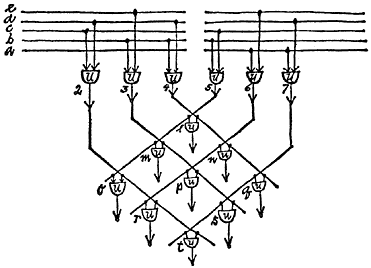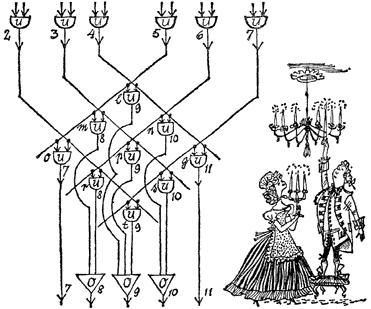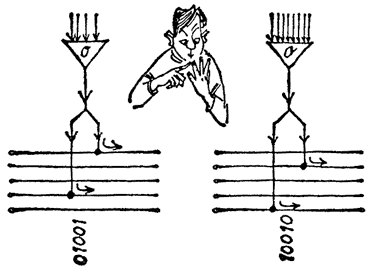Adding by Computer
The crossing wires are insulated so that no current can jump over. But an and-gate is soldered on at every junction. Elementary arithmetic - which applies even to electronic computers - shows that we thus have 100 new and-gates. It is not necessary to draw all of them A section showing nine will suffice:
We have selected in the one direction the leads for 2, 3 and 4, and in the transverse direction those for 5, 6 and 7, as our examples. The nine and-gates have been marked with small letters from "l" to "t."
And now let us finally start counting.
A "00110" arrives over the five wires "a" to "e," is recognized by their and-gate as "2" and is conducted into the network of the matrix.

Illus. 19
A second sign, "10010," runs through the wires "f" to "k." As a "7," it also runs into the matrix. Pulse "2" from the left, and "7" from the right, meet in and-gate "t." The "t" reacts and emits a new pulse. It means 2 plus 7, or 9.
If two pulses from lead "3" and cross-lead "5" meet, and-gate "m" responds and emits a pulse that means "8." In the case of "2" and "6," and-gate "r" is responsible. It also delivers an "8."
If we want to do the job thoroughly we can draw up a table showing the and-gates and the totals belonging to them:
| l = 9 m =8 n =10 o = 7 p = 9 |
q = 11 r = 8 s = 10 t = 9 |
You must not forget, of course, that we are dealing here with only a small sector of the matrix, not even with a tenth of its capacity. The 100 and-gates of a complete adder matrix give all numbers between 0 (for 0 + 0 = 0) and 18 (for 9 + 9 = 18). The totals 0 and 18 occur only once, all others on several and-gates.
The 9 even appears ten times as a total (0 + 9, 1 + 8 etc., up to 9 + 0). All output leads giving the same total are drawn together by or-gates. In our example, this would look like Illus. 20.

Illus. 20
As in our example, the use of or-gates means that in the complete matrix too there is finally only one output lead for each total from 0 to 18.
The pulses which emerge as a total at the or-gates must now of course be translated back again into the language used by the machine. Pulse "7" must become a "10010," pulse "3" a "01001." But that is the easiest thing in the world. just as you can switch the current on or off for an electric chandelier to one, two or four bulbs as you please, so a pulse can be given simultaneously to several leads. To code the pulses from "3" or "7," all you need do is solder the right wires together. Illus. 21 makes this clear.

Illus. 21
©
by PhiloPhax & Lauftext
& Redaktion Lohberg
Kybernetik
- Was ist das?
First printed in Germany: 1963